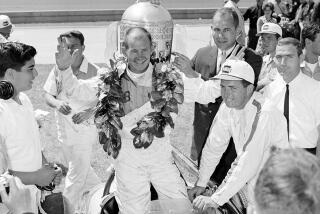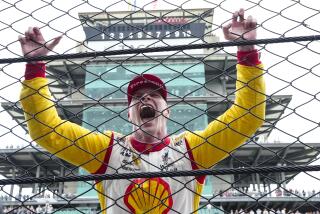THE INDY 500 : Britannia Now Rules Americaâs Biggest Race
INDIANAPOLIS â The British used to say that the sun never set on the British Empire. Today, the sun never sets on a British-built race car. --DAN GURNEY The Indianapolis Motor Speedway, built in 1909 as a proving ground for the fastest and fittest machines from Americaâs growing automotive industry, has become a showcase for British ingenuity.
For the first time, not a single American-built car will start Sunday in the 75th Indianapolis 500.
When Dan Gurneyâs Eagles failed to get up to speed with Jan Lammers and Johnny Parsons driving earlier this month, it left Sundayâs starting field with 24 Marchs, 8 Lolas and 1 Penske--all built in England.
This is the first year since Gurney introduced his All-American Racers Eagles in 1966 that the Santa Ana builder has not had a car in the 500.
The engines for Sundayâs race are nearly as British-dominated. Only three Buick V6 motors, in cars driven by Danny Ongais, Scott Brayton and Jim Crawford, were built in the United States, in Livonia, Mich., by McLaren Engines.
Twenty-nine other cars will be powered by turbocharged Cosworth DFX engines from Northampton, England. The only other motor, in one of Roger Penskeâs cars to be driven by Al Unser, will be a turbocharged Chevrolet V-8.
Donât be misled by that Penske entry with the Chevrolet engine. Penske has his headquarters in Reading, Pa., but the cars are built in Poole, England, and the Chevy V-8 engine in Brixworth, England, by Ilmor Engineering. Ilmor was formed by two former Cosworth engineers, Mario Illien and Paul Morgan.
The last American-built machine to win the Indy 500 was A.J. Foytâs Coyote in 1977. The last time an American-built car won an Indy car race of any kind was at Atlanta in the first event of 1983 when Gordon Johncock drove one of Pat Patrickâs Wildcats to the win.
Up until 1978, when Al Unser won the Indy 500 with a Cosworth-powered Lola, Offenhausers or their Drake-Offy derivative had won 26 Indy races, including one string of 20 in a row. However, by 1981 there wasnât an old four-banger Offy left.
Such statistics immediately bring several questions to mind: Whatâs the matter with American engineers and body builders? Why canât they build a 200-m.p.h. race car to compete here in the heartland of America?
The reasons are many and complex, but it boils down to the fact that--for one reason or another--British design engineers, fabricators and race car mechanics have more expertise and more dedication than their American counterparts.
The matter of cost is also important. Building a race car in England and transporting it to Indianapolis is much less expensive than building it here.
âA good engineer costs twice as much in the United States as he does in England,â Penske said. âLiving costs and labor costs are much lower.
âBut that isnât the bottom line. The most important reason is that race cars in England come out of a high-quality background. The people over there have the expertise, so you go to them, just as Cadillac went to Pininfarina, the famous Italian coach maker, when they decided to build a luxury two-seat car.
âPeople in England are interested in building race cars, not just going racing. Especially the fabricators, the skill groups who make the pieces. Itâs like the coach builders of Italy, itâs a tradition.â
Penske, who has had a race shop in England since he and the late Mark Donohue had a Formula One team in 1973, believes the Formula One influence is another significant factor.
âMost of the Formula One teams are based in England and London is the focal point of the series,â he said. âThere is technological growth up through Formula Three and Formula Two to Formula One and Indy cars among engineers and mechanics just as there is among drivers.
âWhen drivers like Danny Sullivan were learning the trade on European tracks, so were young engineers and potential crew chiefs. Derrick Walker, our team manager, is a good example. He had been a mechanic for Carlos Reutemann on the Brabham Formula One team before he started working for us in Poole. In 1980 we brought him over here to run our racing program.â
Walker, a Scotsman, admits that his Formula One background is behind his work pattern with the Penske team.
âI simply adapted the Formula One style of race car preparation,â Walker said. âThe work gets harder, the competition gets stronger and some variables are different each year, but the basic job is still the same: Put Penske on top.â
So far, the plan is working. Rick Mears will start from the pole with defending champion Danny Sullivan alongside him in a pair of Penske-prepared March-Cosworths. Al Unser will start in the third row in the new Penske-built PC-15 with its Chevy engine.
Gurney, the last American holdout among Indy car builders, sees the British influence as the result of a philosophical difference in priorities and life styles between Americans and Britons.
âThe auto racing business is a microcosm of the world,â Gurney said. âIn the heyday of U.S. passenger cars from Detroit and U.S.-built race cars at Indy, ours was a can-do society as a whole. As the standard of living rose in our country and more and more people became affluent, it became easier to buy products than to build them.
âIn the â60s and â70s, a lot of potential U.S. engineers were siphoned off into the aerospace and defense industries--two taxpayer-funded enterprises. This consumed a stockpile of young engineering minds.
âThis didnât happen in England. There, young graduate engineers had no such windfall financed by the public. They had to find other lines of work, of which auto racing was an important one. Building race cars in England is an industry. Not so, over here.â
Many of the British techniques were developed first by American engineers for the aerospace industry. Another factor, feels Gurney, is an inherent attitude among Americans--American mechanics at least--to resist change.
âWhen the rear-engine concept arrived with Jack Brabham and his Cooper-Climax in 1961 and really caught on in the mid-60s, our guys hung on to the old front-engine concept,â Gurney said. âWhy spend extra money on something new, they rationalized, when they could hold on to the trusty old equipment.
âInstead of going with new technology, they found themselves out in the cold--in much the same manner as the auto industry itself when the Japanese appeared with low price, quality passenger cars.â
Gurneyâs Eagles have won three Indianapolis 500s (1968 and 1975 with Bobby Unser, 1973 with Gordon Johncock) and two national championships, but the last time an Eagle won an Indy car race was in June 1981 when the late Mike Mosley won at Milwaukee. Gurney was unable to qualify a car for this race.
Robin Herd, who heads March Engineering, believes that his companyâs support system is the reason there are so many March cars running here.
âThere is no point in providing the fastest car to a customer if he canât keep it running,â Herd said. âWe like to tell our customers that we run a 24-hour service. Of course, the accountants donât always see it that way when they see stocks of spare parts at the end of the year.â
Vel Miletich, who with his partner Parnelli Jones, pioneered use of a turbocharged Cosworth Formula One engine in 1974 for their Velâs Parnelli Jones Indy cars, blames lack of quality control for the changeover from traditional Offy power to the British engine.
âWe bought our blocks from Drake Engineering and when we tested them, we found about one in ten were up to quality,â Miletich recalled. âWhen I asked them about it, they said, âYou bought them; theyâre yours, not ours.â
âThey had no quality control. We had to go to races with parts that had holes in them. X-rays showed we were buying D-class quality products when we needed A or B, at the worst.â
Thatâs when Miletich, a Torrance auto dealer, and Jones, the 1963 Indy 500 winner, decided to take a normally aspirated Cosworth from their Formula One team and turbocharge it for their Indy cars.
Miletich, like Penske, found the pool of engineers much more bountiful in England--and also like Penske, much less expensive.
âWe built our Formula One car in Torrance, but had to keep it in England because thatâs where the mechanics were. We advertised for racing mechanics here and couldnât find enough good ones, but when we advertised over there we had dozens of qualified applicants.
âThere is a hell of a difference in dedication. In England, it takes seven years of apprenticeship and school to become a full-fledged racing mechanic. Over here, a kid goes to school for six months and thinks he knows it all.
âPrices donât compare. It cost Ford $11 million to develop the Ford engine we used in â70 and â71. When we went to Cosworth, we found we could build three engines for $350,000. Besides that, in addition to the Cosworth engines, the best components--rods, pistons, ignition boxes, fuel injection systems, transaxles, all those extra things you need, are built in England.â
Building an Indy car has come a long way from the days when A.J. Watson welded a tube frame together from chalk marks on the floor of his garage in Glendale.
Now it takes a battery of design engineers and technicians working on an assembly line in England to create enough 750 horsepower racing cars to run the Indianapolis 500.
More to Read
Go beyond the scoreboard
Get the latest on L.A.'s teams in the daily Sports Report newsletter.
You may occasionally receive promotional content from the Los Angeles Times.










